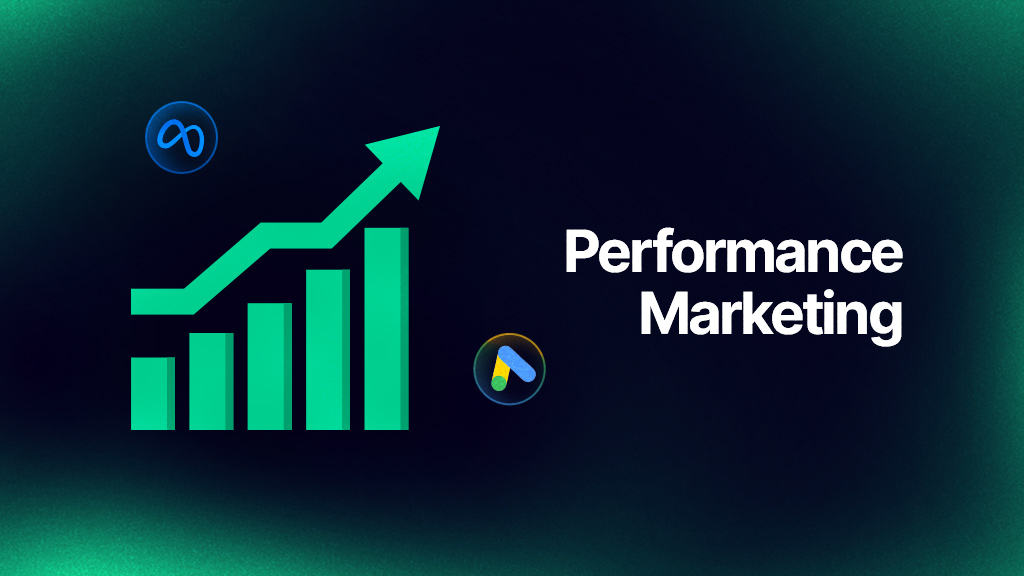An Ultimate Guide to Performance Marketing: Things You Need to Know in 2025

Table of Contents
- Increase Your Ecommerce Sales from $1 million to $100 Million
- Is Affiliate Marketing the Same as Performance Marketing?
- How Does Performance Marketing Work?
- What are the Benefits of Performance Marketing?
- How Do You Measure Performance Marketing?
- What are the Most Common Types of Performance Marketing?
- What are Some Performance Marketing Tips for Being Successful?
- Things To Know About Performance Marketing
Performance marketing has completely changed how companies approach their digital advertising strategies. So what is performance marketing? It has emerged as a powerful approach, allowing companies to pay only for specific actions, like clicks, leads, or sales. With a focus on measurable outcomes and tactics like PPC campaign optimization, this form of digital marketing ensures that every dollar spent contributes directly to achieving specific goals.
As we move into 2024, understanding performance marketing definition, ins and outs is essential for any business looking to stay competitive and grow effectively. This ultimate guide will walk you through the key concepts, benefits, and strategies that define performance marketing in 2024, equipping you with the knowledge to perform better ad optimization and drive your business forward.
Increase Your Ecommerce Sales from $1 million to $100 Million
Scaling an eCommerce business from $1 million to $100 million in sales is no easy task, but with the right performance marketing strategies, it’s entirely achievable. By using data-driven strategies, businesses can optimize their ad spend, target the right audience, and use channels that deliver the highest returns.
Key tactics include personalized ad campaigns, retargeting potential customers, and optimizing landing pages to convert clicks into sales. You can create a scalable growth strategy that provides significant revenue. Whether it’s optimizing your product pages, improving user experience, or using advanced targeting methods, performance-based marketing offers the tools needed to take your business to new heights.
Is Affiliate Marketing the Same as Performance Marketing?
While affiliate marketing and performance marketing share similarities, they are not the same. Affiliate marketing is a subset of performance based marketing, where businesses collaborate with individuals or companies (affiliates) who promote their products or services in exchange for a commission on sales or leads.
Performance marketing, on the other hand, is broader and includes any type of marketing activity where payment is based on specific actions, such as clicks, sales, or leads. Essentially, affiliate marketing is just one tactic within the larger performance advertising strategy, which can include various channels like search engine marketing, social media advertising like Facebook advertising, and more.
How Does Performance Marketing Work?
Performance marketing is based on a simple yet powerful concept. You only pay for specific, measurable actions. Unlike traditional marketing, where businesses might pay upfront for ad space or impressions, performance marketing ensures that every dollar spent contributes directly to the targeted goal. This could be anything from a sale, a lead form submission, or even a video view.
The process typically begins with setting clear goals, such as increasing sales or generating leads. Next, you identify the right performance marketing channels to reach your target audience, including search engines, social media platforms, or affiliate networks. Once your campaigns are live, they are continuously monitored and optimized based on performance data, such as click-through rates (CTR), conversion rates, and cost per acquisition (CPA).
Because this data-driven approach allows real-time adjustments to improve results, your marketing efforts will be efficient and effective. By focusing on outcomes rather than just exposure, performance marketing delivers a more accountable and ROI-driven strategy for businesses.
What are the Benefits of Performance Marketing?

Performance marketing offers several benefits that make it an essential strategy for businesses looking to maximize their digital advertising efforts:
Cost Efficiency: One of the most significant advantages is that you only pay for actual results. Whether it’s a sale, a lead, or a click, you’re spending money on actions that directly contribute to your goals, ensuring that your budget is used effectively.
Measurable Results: Every aspect of a performance marketing campaign is trackable, from impressions to conversions. This transparency allows you to analyze which strategies are working and where improvements can be made, giving you complete control over your marketing efforts.
Targeted Advertising: Performance marketing enables precise targeting, allowing you to reach your ideal audience with advanced ads. This increases the likelihood of conversion as you engage users who are more likely to be interested in your products or services.
Flexibility and Scalability: You can adjust your campaigns in real time based on their performance. This flexibility allows you to scale successful campaigns quickly or change strategies that aren’t delivering the desired results.
Improved ROI: By focusing on specific, measurable outcomes, performance marketing typically delivers a higher ROI compared to traditional marketing methods. The ability to track and optimize campaigns ensures that your ad spend generates the maximum possible value.
How Do You Measure Performance Marketing?
Key Performance Indicators (KPIs) are essential for tracking the success of your performance marketing campaigns. These metrics provide insights into how well your ads are performing and whether your marketing efforts are achieving your desired goals. Here are the ad metrics you should track:
- Cost Per Acquisition (CPA): CPA measures the cost associated with acquiring a new customer or lead. It’s calculated by dividing the total spend by the number of conversions. Lowering your CPA is a sign that your campaigns are becoming more efficient.
- Cost Per Click (CPC): CPC measures the amount you pay for each click on your ad. It’s important for understanding how much you’re spending to drive traffic to your site and for optimizing your budget allocation.
- Cost Per Mille (CPM): CPM, or cost per thousand impressions, tells you how much you’re paying for every 1,000 times your ad is shown. This metric is useful when your goal is to reach more than immediate action.
- Cost Per Lead (CPL): CPL tracks the cost associated with acquiring a new lead. It’s particularly important for businesses focused on generating leads rather than direct sales.
- Conversion Rate: Conversion rate is the percentage of users who complete a desired action, such as making a purchase or signing up for a newsletter, after interacting with your ad. A higher conversion rate indicates that your marketing message is effective.
- Return on Ad Spend (ROAS): ROAS measures the revenue generated for every dollar spent on advertising. A higher ROAS means your campaigns are generating more revenue relative to their cost.
- Return on Investment (ROI): ROI goes a step further than ROAS by considering the overall profitability of your marketing efforts. It’s calculated by subtracting the cost of the campaign from the revenue generated and dividing that by the campaign cost.
- Lifetime Value (LTV): LTV estimates the total revenue a customer is expected to create during their engagement with your business. Understanding LTV helps you determine how much you can afford to spend on acquiring new customers and guides long-term marketing strategies.
Tracking these metrics allows you to assess the marketing performance and make data-driven decisions that optimize results. By regularly analyzing these metrics, you can optimize your strategies to improve efficiency, reduce costs, and maximize returns.
What are the Most Common Types of Performance Marketing?
Performance marketing includes various strategies that allow businesses to pay for specific outcomes, making it a flexible and results-driven approach. Here are the most common types of performance marketing:
Affiliate Marketing
Affiliate marketing involves working with individuals or companies (affiliates) who promote your products or services in exchange for a commission on sales, leads, or other actions. Affiliates use their platforms, such as blogs, websites, or social media, to drive traffic to your business, making this a cost-effective way to expand your reach.
You only pay for the actual results generated by the affiliates, and it ensures that your budget is efficiently used in your performance advertising.
Search Engine Marketing (SEM)
Search Engine Marketing (SEM) focuses on promoting your business through paid ads on search engines like Google. Advertisers bid on specific keywords, and their ads appear in search results when users search for those terms.
SEM is highly effective for providing intent-driven traffic, as it targets users who are actively searching for products or services similar to what you offer. Common SEM strategies include:
- Pay-Per-Click (PPC) advertising: It involves bidding on keywords and paying for each click on your ad.
- Search engine optimization (SEO): It involves optimizing your website’s content and structure to improve its organic search engine rankings.
Social Media Advertising
Social media platforms like Facebook, Instagram, LinkedIn, and Twitter offer powerful advertising tools that allow you to target specific audiences based on demographics, interests, and behaviors. Social media advertising can be used for various goals, from brand awareness to direct conversions. You can create ads in various formats, including text, images, and videos.
You can pay for different actions, such as clicks, likes, shares, or sales, depending on your campaign objectives. This type of performance marketing advertising is particularly effective for reaching and engaging a broad audience.
Native Advertising
Native advertising involves placing ads that match the look and feel of the platform they appear on. These ads blend seamlessly with the surrounding content, making them less intrusive and more engaging for users.
Native ads can be found in social media feeds like Facebook advertisements, content websites, or news platforms, and are designed to provide a more natural user experience. Payments for native ads are typically based on clicks or other performance metrics, and it ensures that you only pay for successful engagements.
Display Advertising
Display advertising involves placing ads on websites and apps in the form of banners, pop-ups, and other visual elements. These ads can be targeted to specific demographics, behaviors, or interests, allowing you to reach a highly relevant audience.
Display ads are often used for brand awareness, retargeting, or driving direct conversions. Payment models for display advertising can vary, but common options include pay-per-click (PPC) or pay-per-impression (CPM), where you pay for every thousand times your ad is shown.
By understanding and using these common types of performance marketing, businesses can create effective campaigns that deliver measurable results across various channels.
| Performance Marketing Type | How It Works | Best For | Payment Model |
|---|
| Affiliate Marketing | Affiliates promote your product in exchange for a commission. | E-commerce, SaaS, lead generation. | Pay-per-sale (PPS), pay-per-lead (PPL), pay-per-click (PPC). |
| Search Engine Marketing (SEM) | Paid ads appear on search engines like Google & Bing. | Driving traffic, lead generation, intent-based marketing. | Pay-per-click (PPC), cost-per-thousand impressions (CPM). |
| Social Media Advertising | Paid promotions on Facebook, Instagram, LinkedIn, etc. | Brand awareness, customer engagement, direct conversions. | CPC, CPM, cost-per-engagement (CPE). |
| Native Advertising | Ads blend with the platform’s organic content. | Content-driven marketing, increasing engagement. | CPC, CPM. |
| Display Advertising | Banner ads shown across various websites & apps. | Retargeting, brand awareness, increasing visibility. | CPM, CPC. |
What are Some Performance Marketing Tips for Being Successful?

Achieving success in performance marketing requires a strategic approach that combines data analysis, audience targeting, and continuous campaign optimization. Here are some tips to help you maximize the effectiveness of your performance marketing efforts:
Set Clear Goals
Before launching any performance marketing campaign, define specific, measurable, achievable, relevant, and time-bound (SMART) goals. Whether you’re aiming to increase sales, generate leads, or improve brand awareness, having specific objectives will guide your strategy and provide benchmarks for success. Clear goals also help you allocate your budget effectively and measure the impact of your campaigns.
Know Your Audience
Understanding your target audience is important for creating personalized and effective marketing campaigns. Use data-driven insights to identify your audience’s demographics, preferences, and online behaviors. The better you know your audience, the more you can personalize your messaging and offers to meet their needs, and it leads to higher engagement and conversion rates.
Use Multiple Channels
Diversifying your performance advertising efforts across multiple channels, such as search engines, social media, and email, helps you reach your audience wherever they are.
Different channels offer unique advantages, and a multi-channel approach allows you to maximize your reach and impact. This strategy also provides opportunities to test different approaches and see which channels perform best for your goals.
Focus on Quality Over Quantity
While it might be tempting to reach as many people as possible, targeting a smaller, more relevant audience often delivers better results. Focus on generating high-quality leads that are more likely to become loyal customers, rather than trying to appeal to everyone.
This can be achieved by creating valuable content, building relationships with your audience, and providing excellent customer service. A well-targeted campaign with a high-quality audience will typically deliver a higher return on investment (ROI) than a broader, less focused approach.
Test and Optimize Continuously
Performance marketing is an ongoing process that requires constant testing and optimization. Experiment with different ad creatives, landing pages, calls-to-action (CTAs), and targeting options to see what works best.
Use A/B testing to compare variations and gather data on what resonates with your audience. Then, optimize your campaigns based on these insights to improve performance and drive better results.
Use Automation Tools
Automation tools can significantly improve your performance marketing efforts by streamlining campaign management and providing real-time data insights.
These tools help you automate repetitive tasks, schedule social media posts, manage bids, and optimize your campaigns efficiently. By using automation, you can focus on strategy and creative development, and it ensures that your campaigns are always running at peak performance.
By following these strategies, you can create more effective performance marketing campaigns that drive meaningful results and help you achieve your business objectives.
Things To Know About Performance Marketing

Performance marketing is a powerful strategy that requires a deep understanding of its complexities to be successful. Here are some key considerations and insights to help you navigate this approach effectively:
Can I do performance marketing myself, or should I hire outside resources?
Whether to manage performance marketing in-house or hire outside resources depends on your team’s expertise, time, and budget. Here’s an overview to help you decide:
- Your team’s expertise: Do you have the necessary skills and knowledge to manage performance marketing campaigns?
- Time and resources: Do you have the time and resources to dedicate to performance marketing?
- Campaign complexity: Is your campaign relatively simple, or does it involve complex strategies and tactics?
- Budget: Can you afford to hire outside resources?
If you have a strong understanding of performance marketing principles, have the time to dedicate to it, and your campaign is relatively straightforward, you may be able to handle it in-house. However, if you lack expertise, are short on time, or your campaign is complex, hiring an agency, using a SaaS platform for ad management or consultant can be beneficial.
Here’s a quick comparison:
In-house:
- Pros: Cost-effective, greater control, deeper understanding of your business
- Cons: Requires time and resources, potential for limited expertise
Outsourcing:
- Pros: Access to specialized expertise, time-saving, can focus on other areas of your business
- Cons: Can be costly, potential for less control
Ultimately, the best approach for you depends on your specific circumstances and goals. Consider your business’s particular needs, budget, and your team’s expertise when deciding whether to manage it yourself or hire outside resources.
What are the most common mistakes to avoid in performance marketing?
Performance marketing can be incredibly effective, but certain mistakes can put at risk your success. Here are some of the most common pitfalls to watch out for:
- Not Setting Clear Goals: One of the biggest mistakes in performance marketing is launching campaigns without clearly defined goals. Without specific, measurable objectives, tracking success or optimizing your efforts is challenging. Ensure that every campaign has clear goals so you can accurately measure performance and ROI.
- Focusing Solely on Immediate Results: Performance marketing often requires a longer-term view to see significant results. Focusing only on short-term gains can lead to premature decisions, such as pausing a campaign before it has had time to gain momentum. Be patient and allow campaigns to run long enough to gather meaningful data that can guide your strategy.
- Ignoring to Track Key Metrics: Another common mistake is failing to monitor marketing performance indicators consistently. Metrics like CPA, CPC, CPM, and ROAS provide valuable insights into your campaign’s effectiveness. Without tracking these metrics, you can’t accurately assess performance or make data-driven adjustments to improve your results.
- Ignoring Automation and Optimization Tools: There are numerous tools available that can automate and optimize various aspects of performance marketing. Ignoring these tools can lead to inefficiencies and missed opportunities. Using automation can help you streamline processes, save time, and improve campaign performance.
By being aware of these common mistakes and actively working to avoid them, you can improve the effectiveness of your campaign management and achieve better results.
How do I target the right audience for my performance marketing

Targeting the right audience is one of the most critical aspects of performance marketing. Without precise targeting, even the most well-crafted campaigns can fail. Here’s how to ensure your marketing efforts reach the right people:
1. Understand Your Existing Customers
Start by analyzing your current customer base. Use tools like Google Analytics, CRM data, and social media insights to gather information about your audience’s demographics, behaviors, and preferences.
Identify patterns in who is purchasing your products or engaging with your content. This data can help you create detailed buyer personas that represent your ideal customers.
2. Create Detailed Buyer Personas
Buyer personas are fictional representations of your ideal customers based on real data. Include details such as age, gender, location, job title, income level, interests, and pain points. These personas help you create your messaging and targeting strategies to resonate with the specific needs and desires of different segments of your audience.
3. Use Advanced Targeting Options
Digital advertising platforms like Google Ads, Facebook, and LinkedIn offer advanced targeting capabilities that allow you to reach specific audience segments. You can target based on:
- Demographics: Age, gender, income, education level, etc.
- Interests: Hobbies, favorite brands, lifestyle choices, etc.
- Behaviors: Purchase history, online activity, device usage, etc.
- Geography: Target users in specific locations, from countries to cities and even down to postal codes.
4. Use Retargeting Strategies
Retargeting helps you to reach people who have already interacted with your brand but haven’t yet converted. By showing them personalized ads based on their previous actions, such as visiting your website or adding items to their cart, you can encourage them to complete their purchase or take another desired action.
Retargeting is a powerful way to stay top-of-mind with potential customers and move them further along the sales funnel.
By following these steps, you can effectively target the right audience for your performance marketing campaigns, and it ensures that your efforts are both efficient and impactful.
Performance Marketing Examples
Performance advertising refers to a variety of strategies, each designed to generate measurable results, such as clicks, leads, or sales. Here are some examples of how it can be applied across different platforms and channels:
Email Marketing
Email marketing can be a highly effective performance marketing channel when focused on specific, measurable actions. For example, an online retailer might run an email campaign offering a discount to subscribers who have previously abandoned their shopping carts. The success of this campaign is measured by the number of users who return to complete their purchases.
Search Engine Optimization (SEO)
While SEO traditionally focuses on improving organic search rankings, it can be approached with a performance marketing mindset by setting specific, performance-based goals. For example, a travel agency might optimize its website for keywords related to “best travel destinations for families.” Success is tracked through metrics such as organic search traffic, click-through rates (CTR), and conversions from search engine results.
Influencer Marketing
Influencer marketing can be performance-based when influencers are compensated based on the results they deliver. For instance, a beauty brand might collaborate with influencers to promote a new line of skincare products. Instead of paying a flat fee, the brand sets up a performance-based agreement where influencers are paid per sale or leads generated through their unique referral links.
Content Marketing
Content marketing can also be approached with a performance marketing focus by measuring the impact of content on specific actions. For example, a B2B software company might create a series of informative blog posts and whitepapers on industry trends. They use performance metrics such as the number of downloads, leads generated from content offers, and the conversion rate of leads into customers.
Pay-Per-Click (PPC) Advertising
PPC advertising is a classic example of performance marketing, where advertisers pay only when users click on their ads. For instance, a local restaurant might run a PPC campaign on Google Ads targeting keywords like “best Italian restaurant near me.” The restaurant pays based on the number of clicks its ad receives, ensuring that their budget is spent on attracting users actively searching for dining options.
The effectiveness of the campaign is measured through metrics like click-through rate (CTR), cost per click (CPC), and conversions.
These examples show how the strategies can be applied to achieve specific, measurable results, ensuring that marketing budgets are spent effectively and that campaigns are optimized for the best possible outcomes.

What is performance based marketing?
Performance-based marketing is a results-first approach where you only pay when a specific action is completed like a lead, a sale, or a click. Think of it as a partnership built on trust: if the campaign doesn’t perform, you don’t pay. It’s the heartbeat of ROI-driven strategies, empowering brands to scale confidently without wasting budget on vanity metrics.
What are performance marketing channels?
Performance marketing channels are digital platforms where every action is trackable and measurable. These include paid search (Google Ads), social ads (Meta, TikTok, LinkedIn), affiliate marketing, native advertising, and retargeting tools. Each channel acts like a faucet you can turn up or down depending on what delivers the best ROI flexible, scalable, and smart.
What are performance marketing terms?
Key performance marketing terms include:
CPA (Cost Per Acquisition) – what you pay per conversion
CPC (Cost Per Click) – cost for each ad click
ROAS (Return on Ad Spend) – revenue return vs ad spend
CTR (Click Through Rate) – how often people click after seeing your ad
These are more than just acronyms—they’re your campaign’s health check, guiding every decision with clarity.
What is performance marketing and how is it different from digital marketing?
Performance marketing is a subset of digital marketing but with a sharp edge. While digital marketing can include brand awareness and content creation, performance marketing is laser-focused on measurable outcomes. You don’t just hope it works you see it in the numbers. It’s the difference between setting sail with a compass or just following the stars. One gives you direction. The other? A gamble.


